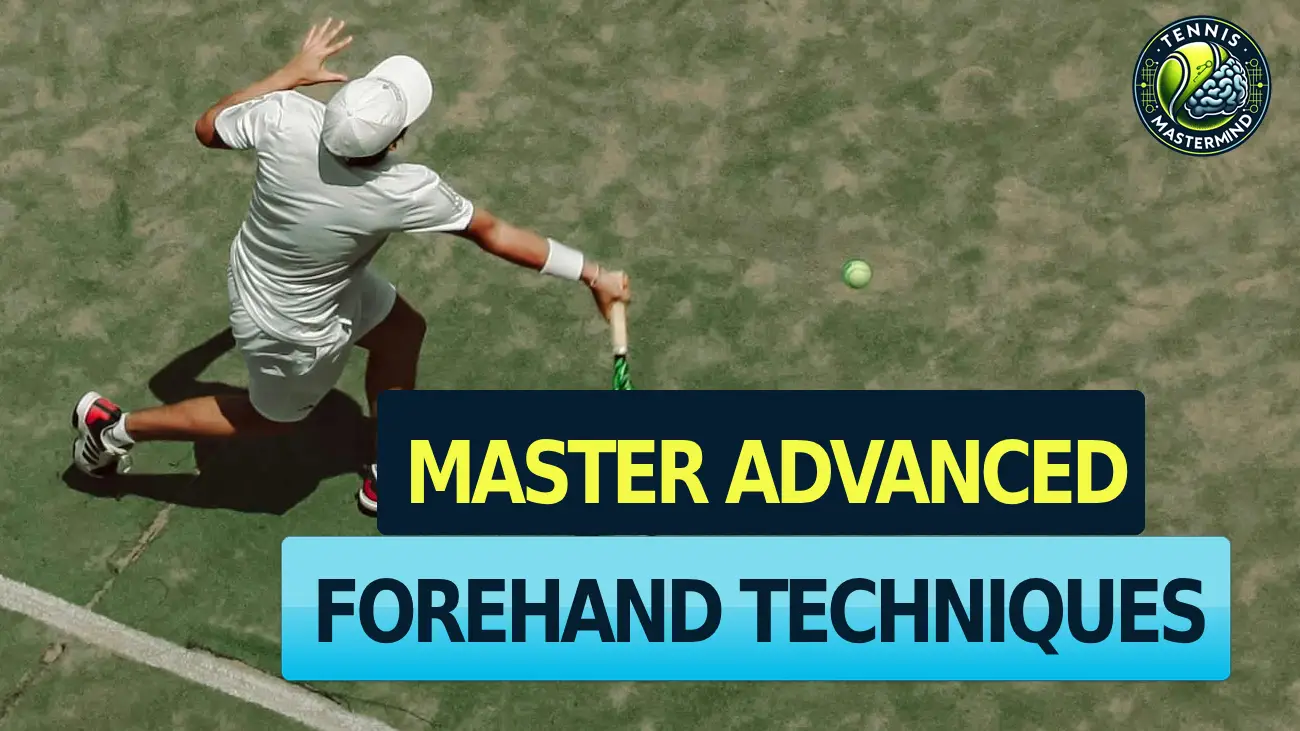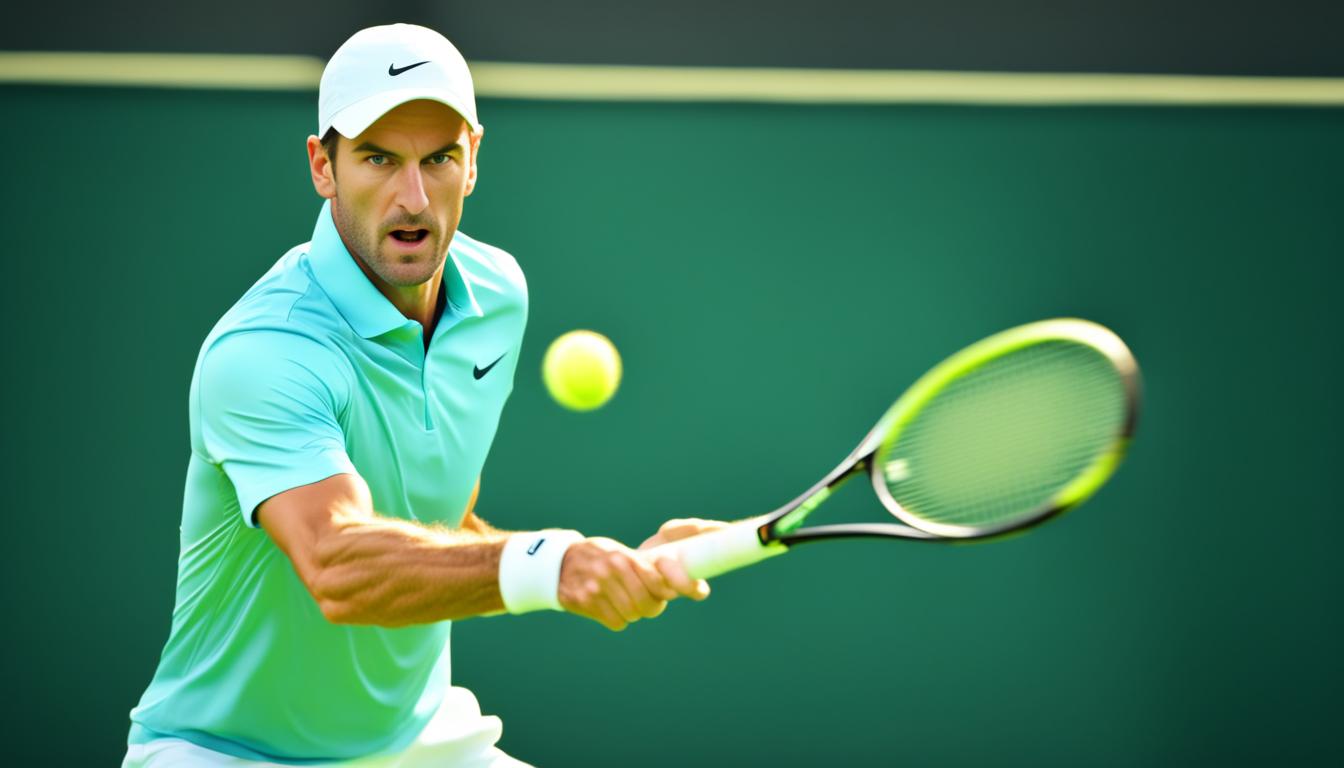Welcome to our comprehensive guide on mastering advanced forehand techniques in tennis! Whether you’re a beginner looking to take your forehand skills to the next level or an intermediate player seeking expert guidance, this article is for you. We’ll provide you with valuable tips and strategies to help you improve your forehand technique and elevate your performance on the court.
As we dive into the world of advanced forehand techniques, you’ll learn the secrets behind a powerful and controlled forehand stroke. From the correct grip to the preparation phase and the leveraging of gravity, we’ll cover all the essential elements that contribute to a winning forehand. Get ready to unleash your true potential and dominate the tennis court with your improved forehand skills!
Key Takeaways:
- Mastering advanced forehand techniques can take your tennis game to new heights.
- The correct grip, footwork, and preparation are key elements in executing a powerful forehand stroke.
- Leveraging gravity through proper drop and swing path can make your forehand more effortless and effective.
- Consistent practice and dedication are essential to improving your forehand skills.
- By mastering advanced forehand techniques, you can elevate your overall performance on the tennis court.
The Grip – An Essential Element of the Forehand Technique
When it comes to mastering the forehand technique in tennis, the grip is a crucial component that can greatly impact your performance on the court. A correct and stable grip allows for optimal control and reliability during your swings. In this section, we will explore the importance of the forehand grip and provide guidance on achieving a stable and reliable grip.
The semi-western grip is widely regarded as the most effective grip for executing powerful forehand strokes. It offers a balance of control and spin, allowing you to generate substantial racket head speed while maintaining accuracy. To achieve the semi-western grip, start by placing your palm on the bottom bevel of the racket handle. Then, rotate your hand slightly towards the right (for right-handed players) or left (for left-handed players) so that the base knuckle of your index finger rests on the 3rd bevel.
A stable and reliable grip is essential for a consistent and powerful forehand stroke. To achieve this, ensure that you maintain a firm grip on the racket without excessive tension. Avoid squeezing the racket too tightly as it can limit your wrist movement and hinder your ability to generate racket head speed. Instead, aim for a grip that feels comfortable and secure, allowing for natural wrist flexion and extension.
One technique that can improve the stability of your grip is the “index finger technique.” This involves applying slight pressure with your index finger on the base knuckle, which helps to stabilize the racket during the swing. By utilizing the index finger technique, you can enhance your control and prevent the racket from twisting or turning in your hand.
| Grip Type | Description |
|---|---|
| Semi-Western Grip | A grip where the base knuckle of the index finger rests on the 3rd bevel of the racket handle. |
| Eastern Grip | A grip where the base knuckle of the index finger aligns with the 2nd bevel of the racket handle. |
| Continental Grip | A grip where the base knuckle of the index finger aligns with the 1st bevel of the racket handle. |
By mastering the correct forehand grip and incorporating the index finger technique, you can develop a stable and reliable grip that will greatly enhance your forehand technique. Practice consistently and pay attention to finding a grip that feels comfortable and secure for you. With time and dedication, you’ll notice a significant improvement in your forehand strokes and overall performance on the tennis court.
The Ready Position & State – Preparing for a Powerful Forehand
In tennis, the ready position and state play a crucial role in setting the stage for a powerful forehand shot. Being in the right position and maintaining readiness and responsiveness on the court can greatly enhance your performance and allow you to execute your forehand technique with precision.
Effective footwork is key to achieving the ready position and state. Continuous movement and quick split steps ensure that you are always on your toes, ready to react to any shot. This dynamic footwork enables you to cover the court efficiently and position yourself optimally for a strong forehand stroke.
When transitioning from one side of the court to another, a split step is essential. This momentary pause in mid-air, as your opponent strikes the ball, helps you maintain balance and prepares your body for explosive movement in the desired direction. The split step sets the foundation for an explosive and well-timed forehand shot.
Footwork is not limited to lateral movement alone but also involves efficient forward and backward motion. By mastering movement on the court and having a solid technical foundation, you can generate more power and maintain control during your forehand stroke.
Visualize a table including the key elements of footwork in the ready position:
| Footwork Technique | Description |
|---|---|
| Continuous Movement | Maintain continuous footwork to stay light on your feet and respond quickly to any shot. |
| Split Step | Use the split step to prepare your body and maintain balance when transitioning between shots. |
| Forward & Backward Motion | Develop the ability to move efficiently in both forward and backward directions, enabling you to adjust your position and generate power during your forehand stroke. |
By focusing on the ready position, ready state, and mastering footwork techniques, you can maximize the potential of your forehand shots. The right footwork allows you to generate more power, maintain control, and position yourself for success on the tennis court.

The Preparation – Setting the Stage for a Strong Forehand
When it comes to executing a powerful forehand stroke in tennis, the preparation phase plays a crucial role. Proper preparation sets the stage for a strong and controlled swing, ensuring maximum impact and accuracy. In this section, we will explore the key elements of the preparation phase, including turning to the side, using the off-hand, wrist position, and the semi-western grip.
Turning to the Side
One essential aspect of the preparation phase is turning your body to the side. This allows you to generate rotational power and transfer it into your forehand shot. By turning your body, you engage your core muscles and create a solid foundation for an explosive swing. Remember, the more you rotate your body, the more power you can generate in your shot.
Using the Off-Hand
The off-hand, the non-dominant hand, plays a pivotal role in positioning and balance during the preparation phase. Use your off-hand to stabilize your body and guide the racket into the ideal position. As you turn to the side, bring your off-hand across your body, pointing towards the net. This action helps maintain balance and aids in coordinating your swing.
Optimizing Wrist Position
Proper wrist position is essential for a controlled and efficient forehand stroke. As you prepare to swing, keep your wrist firm but flexible. Avoid excessive tension, as it can hinder your shot’s fluidity. The wrist should be slightly cocked back, ready to uncoil and accelerate the racket head through the ball. Maintaining a neutral and relaxed wrist position allows for a quick and powerful release of energy.
The Semi-Western Grip
The choice of grip significantly affects the quality of your forehand stroke. The semi-western grip is widely favored by professional players for its balance of power and control. It involves placing the base knuckle of your index finger on the third bevel (counterclockwise) of the racket handle. This grip allows for an optimal combination of topspin and power, giving you better control over your shots.
“The preparation phase is crucial in setting up for a strong forehand stroke. By turning to the side, using the off-hand, positioning the wrist correctly, and adopting the semi-western grip, players can prime themselves for powerful and accurate shots on the tennis court.”
By focusing on these key elements during the preparation phase, you can effectively establish a solid foundation for an authoritative forehand stroke. Turning to the side, utilizing the off-hand, optimizing wrist position, and employing the semi-western grip are surefire ways to elevate your forehand game. The next section will delve into the concept of the drop and how it can help you generate effortless acceleration in your forehand shots.
The Drop – Leveraging Gravity for an Effortless Forehand
The forehand drop is a fundamental technique that allows players to harness the power of gravity for effortless acceleration of the racket. By understanding and mastering the dropping technique, you can improve your forehand stroke and achieve greater consistency and control on the court.
The key to executing a successful forehand drop lies in the proper racket swing path. As you initiate the stroke, imagine a smooth arc where the racket head drops below the ball before making contact. This downward motion creates gravity-assisted acceleration, enabling you to generate power without exerting excessive effort.
Focus on simplicity and accuracy in your execution, rather than trying to replicate the advanced techniques used by professional players. By following these steps, you can develop a reliable and effective forehand drop:
- Take your stance in the ready position with your knees slightly bent and your weight balanced evenly between your feet.
- Grip the racket firmly, ensuring a stable and comfortable hold.
- As the ball approaches, begin the dropping technique by turning your shoulders and hips sideways.
- Let your racket drop naturally as your arm extends and your wrist stays loose.
- Maintain a relaxed grip and focus on a continuous swing path, ensuring that your racket face remains perpendicular to the net until contact with the ball.
- Make contact with the ball at the optimal point, slightly in front of your body.
- Follow through with the swing, allowing your racket to finish high and across your body.
By utilizing the forehand drop, you can add depth, control, and power to your shots. Practice this technique consistently, both during drills and in actual match play, to develop muscle memory and enhance your overall performance.

Conclusion
In conclusion, this article has provided a comprehensive overview of advanced forehand techniques in tennis. We have highlighted the importance of mastering the proper grip, refining footwork and preparation, and understanding the optimal swing path for a powerful and controlled forehand stroke. By implementing the expert guidance and tips we have provided, players can significantly improve their forehand skills and elevate their performance on the tennis court.
With dedicated practice and perseverance, players can develop advanced forehand techniques that will lead to improved skills and elevated performance. The combination of a stable and reliable grip, efficient footwork, and meticulous preparation will enhance the power and accuracy of each forehand shot. This comprehensive approach to the forehand stroke will ensure players are able to dominate rallies and dictate play during matches.
By focusing on the key elements discussed in this article, players can achieve an elevated forehand performance that will set them apart on the tennis court. Practice the correct grip, refine your footwork, and consistently work on the optimal swing path to unlock the full potential of your forehand. With time and dedication, these advanced forehand techniques will become second nature, leading to improved consistency, accuracy, and control in your overall tennis game.




